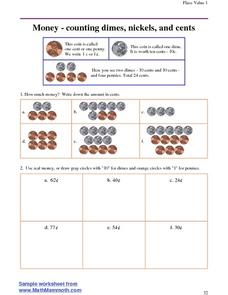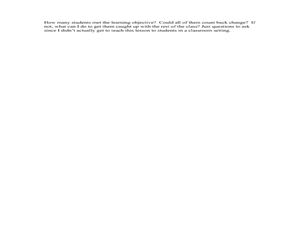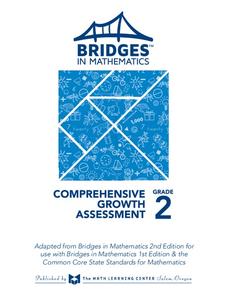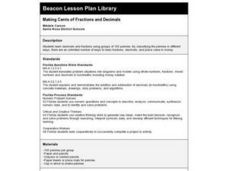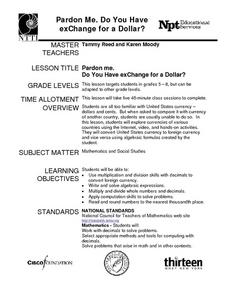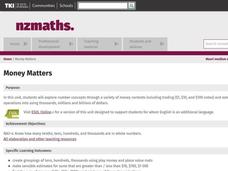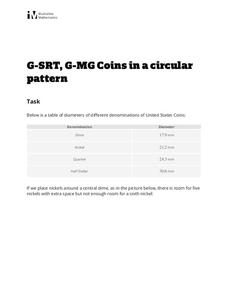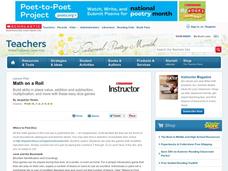Curated OER
Money in Action
Students become familiar with the various coins in our money system as well as amount of each coin. They help develop their ability to count change and find different ways to show equal amounts.
Curated OER
Christmas Word Problems
Here's a little holiday-oriented math review/challenge. Three-up on a single sheet for copying, each set consists of five problems that range from three- and four-digit subtraction to multiplication and division to four and five. Typo...
Curated OER
Money - counting dimes, nickels, and cents
In this counting dimes, nickels, and pennies learning exercise, students review pictures of coins with their values, count money and write the total amounts, and use real money to show given amounts of change. Students write twelve answers.
Curated OER
Money Game
Fourth graders give change of one dollar. In this decimal and fractions lesson, 4th graders receive fake coins and discuss what they could purchase with them. Students go for a walk and spend one dollar and get...
Elementary AMC
Earth Day Math
Take some time this Earth Day to nourish the growth of your young mathematicians with this series of task cards. Whether it's the four basic operations, place value, money, or elapsed time, these conservation-themed problems...
Math Learning Center
Third Grade Assessments and Scoring Checklists, Common Core State Standards
How are your learners doing with place value? Track their skill levels with a set of math assessments. The packet includes worksheets to hand out to your class, scoring checklists, a calendar for implementation, and instructions for...
Bridges In Mathematics
Grade 2 Comprehensive Growth Assessment
Need to know if your students comprehend all the Common Core standards covered in second grade? This growth assessment will let you know. Find out if your second graders can add/subtract, tell the time, read a bar graph, know their...
Curated OER
Making Cents of Fractions and Decimals
Students explore decimals and fractions using groups of 100 pennies. By classifying the pennies in different ways, there are an unlimited number of ways to learn fractions, decimals, and place value in money. This is a good, hands-on...
Curated OER
Addition and Subtraction up to 100
After reviewing double-digit addition and subtraction up to and from 100, learners are introduced to addition and subtraction up to and from 10,000. A grid is used along side number decomposition to help them solve a word problem...
Curated OER
Pardon Me. Do You Have Change For a Dollar?
Upper elementary and middle school learners explore currencies from a variety of countries. They use the Internet, video, and engage in hands-on activities. They practice converting U.S. currency to foreign currency and vice versa. This...
Curated OER
Money Matters
Third graders make fair trades and exchanges of their money in order to have practical experiences with the essential "rules" of our place value system. They create groupings of tens, hundreds, thousands using play money and place value...
Illustrative Mathematics
Coins in a Circular Pattern
What starts as a basic question of division and remainders quickly turns abstract in this question of related ratios and radii. The class works to surround a central coin with coins of the same and different values, then develops a...
Curated OER
Comparing Values: Comparisons Between Musical Notation and Money
Students identify ways in which the principles and subject matter of other disciplines taught in school, specifically math, are interrelated with those of music.
Curated OER
Money Place Value Chart
In this money worksheet, students complete a chart showing the value of money and how the amount of money could be written in words. Five examples are given. Fifteen more numbers can be added. Money amounts are given in pounds.
Curated OER
Buying New Stuff
Young spenders take a look at the best ways to save and spend money. This type of financial education is lacking in schools, so implementing this lesson would be of great value to your students. Things like bank checking account fees,...
Curated OER
Quarter, Nickel, Dime....
An engaging game called, "Quarter, Nickel, and Dime" is presented in this math lesson. Players are given an envelope with slips of paper that represent the three coins. In pairs, they play the game 18 times, and the whole class charts...
Curated OER
Math on a Roll
Students practice various math skills using a polyhedral die. In this dice game lesson, students practice multiplication, addition, place value, and money using games. Standard dice may be used instead of a polyhedral die with...
Curated OER
Comparing and Ordering Greater Numbers
Young scholars line up the digits of the numbers they are comparing in the correct manner. In this comparing numbers lesson plan, students learn to line numbers up correctly on a place value chart before comparing them. Young scholars...
Curated OER
Discovering Decimals
Learners explore decimals. They use personal computers to compare decimal numbers and examine place value. Students participate in an animation game to complete decimal problems.
Curated OER
Number Sense
First graders practice rounding 4 digit numbers using place value concepts. In this estimating sums and differences activity, 1st graders explore clustering, rounding, and front end estimation as methods for rounding decimals.
Curated OER
Money Math Carnival
Third graders explore money in a carnival format. In this money lesson plan, 3rd graders create a carnival of mathematics activities. Students determine the value of money in mixed amounts and explore how to create representations of money.
Curated OER
We're in the Money
Students study money and its place in the economy. In this middle school Consumer Math lesson, students explore the barter system and the need for money. Students explore how money works in society and explore modern money...
Curated OER
The History of Money
For this social studies worksheet, students investigate the history of paper money and coins. Students read paragraphs about what early people used for money and what kinds of banks were used. Students complete a crossword puzzle.
Curated OER
Cyber Currency, Currently
Students explore the value of currency and how to save and earn interest. In a key lesson, kids even get to purchase items in their classroom's general store. It's a fun way to learn the importance of being financially literate!




